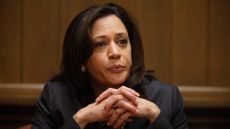Will the Green Party spoil the midterms for Democrats?
Democrats are eager to ride a blue wave. But here comes the Green Party ...

For Democrats, the 2018 midterm cycle has a singular goal: flipping control of Congress.
The House looks likely to turn blue. The Senate is tougher, but not out of the question. But even one chamber would be enormous for Democrats.
But while Democrats contend with midterm voter turnout, increased internal polarization, and grassroots restlessness, another foe could quietly prove dangerous in their mission: the Green Party.
Subscribe to The Week
Escape your echo chamber. Get the facts behind the news, plus analysis from multiple perspectives.

Sign up for The Week's Free Newsletters
From our morning news briefing to a weekly Good News Newsletter, get the best of The Week delivered directly to your inbox.
From our morning news briefing to a weekly Good News Newsletter, get the best of The Week delivered directly to your inbox.
The Green Party is still a relatively new party in U.S. politics. After emerging in the 1980s with a focus on anti-capitalism and environmentalism, the party began fielding candidates for state and local office in 1985. In 1996, it ran Ralph Nader as a presidential candidate, and in 2000 Nader's candidacy was seen as a prime reason George W. Bush defeated Al Gore in Florida — and thus in the entire presidential election. In 2016, Green Party candidate Jill Stein's vote total in key states, like Wisconsin and Pennsylvania, was more than the total difference between Hillary Clinton and Donald Trump, and many have said Stein's campaign spoiled the election for Clinton.
The Green Party has 161 officeholders; two of them are in state legislatures, while the rest hold local office. No Green Party candidate has ever been elected to national office. But the party grew by roughly 40,000 members between 2016 and mid-2018 — and now, as more and more voters become disillusioned by the two major parties, the Green Party is poised to once again play its biggest role: spoiler.
According to Ballotpedia, 47 Green Party members ran in primaries for the House this year. Many of them have gone on to take part in the general election either as write-in candidates or on the ballot. Most of those candidates are running in seats that are considered safely Democratic or Republican, per Cook Political Report, but six are running in elections that fall among the "most competitive" 67 races. Four candidates are running in one of the 30 "toss-up" seats that will likely end up determining who controls the House. In Iowa's 1st District, which is listed as leaning Democratic by just 1 percentage point, a Green Party candidate is running too.
It would be hyperbolic to suggest that any of these candidates will end up in D.C. But a local Ohio special election back in August demonstrates the party's power: In Ohio's 12th District, Green Party candidate Joe Manchik secured just enough votes to keep an automatic recount from being triggered in the race between Republican Troy Balderson and Democrat Danny O'Connor. With just 0.6 percent of the vote, Manchik put enough distance between the two candidates that Balderson's 0.8 percent win went unchallenged. Balderson was sworn into Congress in early September. The trio will face off again in November, but Manchik's minute vote total the first time around reflected the Green Party's spoiler potential — and drew ire from Democrats hopeful to gain the seat.
In several toss-up races, Green Party candidates could upset chances for the Democrats to make up or hold the final few percentage points they need to secure seats. Take Iowa's 3rd District, where the Democratic candidate, small business owner Cindy Axne, holds a roughly 3-point lead over incumbent GOP Rep. David Young. Young was elected in 2014 with a 10-point cushion and re-elected in 2016 with a 14-point spread. But even with Axne in the lead according to some polling, the district has a lot of leeway for change before November: recent Democratic polling showed that 11 percent of voters were undecided, and while Axne is polling higher than Young among registered independents, 26 percent of those voters were undecided too. In past races, including 2016, independent candidates have taken over 5 percent of the vote. Paul Knupp, the Green Party candidate, had previously run in the Democratic primary before filing with the Green Party for the general election, making him one of four independent candidates.
In New York's 19th District, incumbent Rep. John Faso (R) is up against Democrat Antonio Delgado, who polled 3 points ahead of Faso in a Monmouth University poll earlier this month. While the race is considered a toss-up between the two, in 2016 polls showed Faso leading Democratic candidate Zephyr Teachout by just 1 percent before defeating her by a margin of 8 points. Green Party candidate Steven Greenfield is one of two independent candidates on the ballot, and it's hard to say what his candidacy might do to the final results. The last time a Green Party candidate was on the ballot was 2002, when Jonathan M. Wright won 1.5 percent of the vote.
Green Party candidate Diane Moxley is running in New Jersey's 7th District, which encompasses a constituency that has shown a willingness to support independent candidates. Hopeful independents have routinely nicked more than 1 percent of the vote from the major-party candidates in NJ-7, election data shows. Democratic challenger Tom Malinowski led incumbent Rep. Leonard Lance (R) by 3 points in a recent Monmouth poll, though Lance has pulled higher favorability ratings in some surveys. Lance, unlike other Republicans, has made it a point to highlight differences between himself and the president heading into the midterms; he voted against the Republican tax bill and opposes repealing ObamaCare. Malinowski, meanwhile, advocates for universal health care and repealing the GOP tax law, while Moxley also supports single-payer health care. Monmouth's latest numbers show that 2 percent of voters in the district would vote "other" over Malinowski or Lance, while 12 percent remain undecided.
Finally, in Illinois' 12th District, polling from Siena shows Republican incumbent Rep. Mike Bost up by between 1 and 8 points over Democratic challenger Brendan Kelly. Green candidates in the district have secured a significant total of the vote in recent elections, including in 2016, when Green Party candidate Paula Bradshaw took 6 percent of the vote; in the general election, she secured over 18,500 of the district's 313,002 cast ballots. Randy Auxier is this year's Green Party nominee and the only independent candidate in the race. The Green Party's vote total has not decreased in IL-12 in the past four election cycles, and in most cases it has increased. If that trend continues for Auxier, it could make it hard for Kelly to break into Bost's lead.
The Green Party is often not included in polling, and its candidates usually don't take part in debates. It can be difficult to judge the party's electoral impact prior to the final vote tally. But the Green Party has proven it can throw a wrench in the establishment gears, even with its small numbers. Green Party candidates surely bristle at being called potential spoilers, but it is also hard to ignore the ways in which the party has consistently shaped elections even while never getting elected to those offices themselves.
The question heading into November is whether this growing band of voters will continue to make themselves heard — at the cost of a blue wave.
Sign up for Today's Best Articles in your inbox
A free daily email with the biggest news stories of the day – and the best features from TheWeek.com
-
 Today's political cartoons - January 19, 2025
Today's political cartoons - January 19, 2025Cartoons Sunday's cartoons - moving to Canada, billionaire bootlickers, and more
By The Week US Published
-
 5 inflammatory cartoons on the L.A. wildfires
5 inflammatory cartoons on the L.A. wildfiresCartoons Artists take on climate change denial, the blame game, and more
By The Week US Published
-
 The problems with the current social care system
The problems with the current social care systemThe Explainer The question of how to pay for adult social care is perhaps the greatest unresolved policy issue of our time
By The Week UK Published
-
 US election: who the billionaires are backing
US election: who the billionaires are backingThe Explainer More have endorsed Kamala Harris than Donald Trump, but among the 'ultra-rich' the split is more even
By Harriet Marsden, The Week UK Published
-
 US election: where things stand with one week to go
US election: where things stand with one week to goThe Explainer Harris' lead in the polls has been narrowing in Trump's favour, but her campaign remains 'cautiously optimistic'
By Harriet Marsden, The Week UK Published
-
 Is Trump okay?
Is Trump okay?Today's Big Question Former president's mental fitness and alleged cognitive decline firmly back in the spotlight after 'bizarre' town hall event
By Harriet Marsden, The Week UK Published
-
 The life and times of Kamala Harris
The life and times of Kamala HarrisThe Explainer The vice-president is narrowly leading the race to become the next US president. How did she get to where she is now?
By The Week UK Published
-
 Will 'weirdly civil' VP debate move dial in US election?
Will 'weirdly civil' VP debate move dial in US election?Today's Big Question 'Diametrically opposed' candidates showed 'a lot of commonality' on some issues, but offered competing visions for America's future and democracy
By Harriet Marsden, The Week UK Published
-
 1 of 6 'Trump Train' drivers liable in Biden bus blockade
1 of 6 'Trump Train' drivers liable in Biden bus blockadeSpeed Read Only one of the accused was found liable in the case concerning the deliberate slowing of a 2020 Biden campaign bus
By Peter Weber, The Week US Published
-
 How could J.D. Vance impact the special relationship?
How could J.D. Vance impact the special relationship?Today's Big Question Trump's hawkish pick for VP said UK is the first 'truly Islamist country' with a nuclear weapon
By Harriet Marsden, The Week UK Published
-
 Biden, Trump urge calm after assassination attempt
Biden, Trump urge calm after assassination attemptSpeed Reads A 20-year-old gunman grazed Trump's ear and fatally shot a rally attendee on Saturday
By Peter Weber, The Week US Published